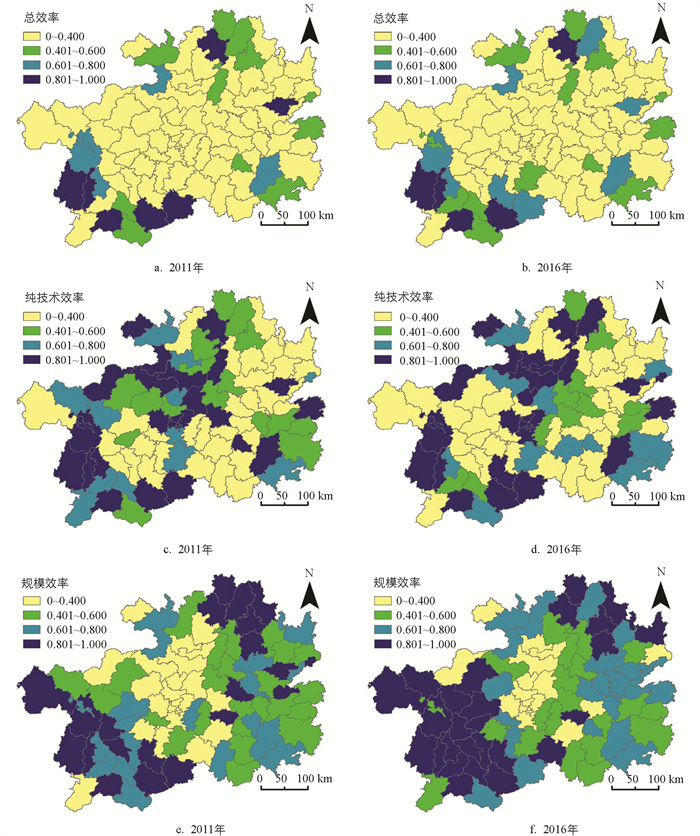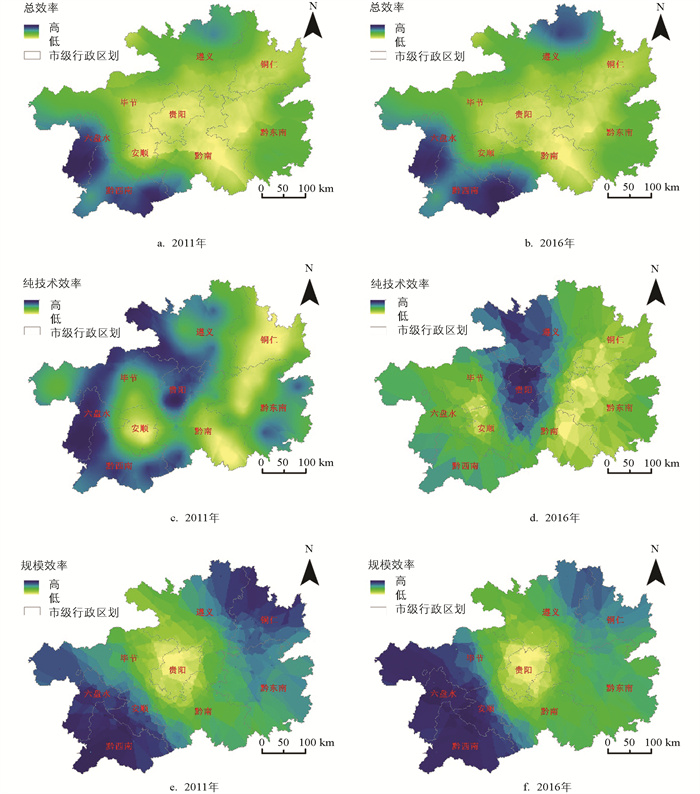-
开放科学(资源服务)标志码(OSID):

-
目前我国脱贫攻坚已经取得全面胜利,如何发挥区域旅游资源的乘数效应,将资源优势转化为社会经济优势,进一步提高旅游减贫效率,继而持续助推区域乡村振兴发展,成为学术界关注的焦点. 位于我国西部偏远民族贫困地区的贵州省在解决贫困人口脱贫、迈向全面小康的进程中,充分发挥其生态、环境以及优质旅游资源的优势,采用“大旅游”战略引领区域经济与民生发展,使得旅游经济成为拉动区域经济的重要增长极,贵州省贫困县2020年底全部“脱帽”. 基于此,本研究将贵州省作为典型案例地,探究其旅游减贫效率格局演化及其影响因素,对西部偏远特困地区以及民族地区的旅游生产要素合理化配置和旅游发展提质增效有一定的参考价值.
全文HTML
-
旅游减贫效率是综合衡量区域旅游减贫效果的重要手段,在国内外对旅游减贫相关成果的基础上,近年来关于旅游减贫效率(效应)的探讨逐渐成为学者们关注的焦点. 黄渊基[1]、耿长伟等[2]运用DEA模型对连片特困地区旅游减贫效率进行评价,根据不同发展阶段与区域特点,提出了适宜的发展策略;另有研究采用传统的DEA模型对武陵山区[3]、湖北大别山区[4]、广西石漠化地区[5]、连片特困罗霄山片区[6-7]以及湖北省[8]旅游减贫效率及其影响因素展开测度;尹建军等[9]、梁兴群等[10]基于Super-SBM模型对集中连片特困区的旅游减贫效率及其减贫路径展开探究. 此外,部分学者对贵州省的旅游减贫展开了探究,研究内容主要集中于旅游减贫模式[11]、旅游精准减贫对农户的生计影响[12]、旅游减贫路径与益贫模式[13]等;还有学者聚焦于旅游过程中特定形式的旅游减贫,譬如生态旅游减贫[14]、旅游减贫与空间正义[15]、旅游减贫与劳动保障制度[16]等. 综合来看,这些研究以定性分析居多,尽管有学者基于自回归模型对贵州省旅游减贫效应展开了初步探究[17],但是非线性Granger因果检验只能刻画旅游减贫效率“量”的影响程度,其更多地考虑关系数据而忽略了旅游减贫效率的空间结构属性. 基于此,借助空间分析测定贵州省旅游减贫效率空间格局演化的研究有很大空间.
总体来看,学界对旅游减贫效率进行了较为全面的研究,但相关研究从区域与尺度来看多集中于东中部地区市际层面,少有对西部地区,尤其是西部偏远民族贫困地区微观层面(县域尺度)旅游减贫效率的研究;就指标选取与研究方法而言,旅游减贫效率产出指标大多数只考虑经济效益,忽略了社会效益与生态效益;此外,大多数研究多采用传统DEA以及超效率SBM来测度旅游减贫效率,但传统DEA方法在对小样本估计时会导致相对效率产生偏差或忽略统计检验等问题[18-19],而超效率SBM只能从关系属性的角度刻画旅游减贫效率“量”的影响程度. 因此本研究在构建适宜的投入—产出指标的基础上,借助Bootstrap-DEA、GIS空间分析以及空间计量模型等方法,以贵州省为案例地,以2011-2016年面板数据为数据源,深入探讨西部偏远民族贫困地区旅游减贫效率的空间格局演化规律及其影响因素,以期为贵州省旅游可持续发展以及旅游生产要素合理化配置和提质增效提供决策参考.
-
DEA方法是评价产业投入产出效率较常用的非参数方法,由于传统DEA方法在对小样本估计时会导致相对效率产生偏差或忽略统计检验等问题[18-19],本研究采用引入Bootstrap纠偏的DEA方法来测算旅游减贫效率[20]. 计算步骤为:①利用DEA方法估计决策单元DMUn的效率值θk,k=1,2,…,n;②利用Bootstrap方法对效率值进行m次迭代,记为θ1n*,θ2n*,…,θmn*;③测算样本模型((θk/θmn*)×Xk,Yk);④利用DEA方法对每一个模拟样本估计效率值;⑤重复步骤②至④m次(m取1 000),产生一组效率估计值,即Bootstrap纠偏效率值[21].
-
全局空间自相关主要是对属性在整个区域空间上特征的描述,反映观测变量在整个研究区域内空间相关性的整体趋势. 最常见的是用Moran's I系数来衡量,其计算公式[22]为:
式中:Xi和Xj表示空间单元i与j的属性值;S2为样本方差;Wij均为邻近标准的空间权重矩阵. 统计检验均采用Z检验.
-
根据Anselin的空间滞后模型与空间误差模型[23],结合贵州省旅游发展实际,设定的考虑空间效应的滞后模型为:
考虑空间效应的误差模型为:
式中:γi为回归参数;Yi为区域i的旅游减贫效率;STRi表征产业结构;RESi表征旅游资源禀赋;Li表征人力资本;CPi表征资本动力;OPENi表征市场开放程度;εi为随机干扰项,衡量其他未观测到的因素对旅游减贫效率的影响;ρ为空间滞后回归系数;W为邻近标准空间权重矩阵;λ为空间自相关系数,ξ为服从经典假设的随机误差项.
-
旅游减贫效率是对旅游减贫过程的评价,其评价指标有投入指标和产出指标. 近年来,国内外学者逐渐从关注旅游减贫的经济效益拓展到关注旅游减贫的“经济—生态—社会”效益,因此旅游减贫效率评估既要注重合理分配利益,防止贫富差距过大,突出经济效益,还要注重可持续发展,突出社会与生态效益[1].
由于投入指标的选取需要评价的是旅游对经济、社会与生态的减贫效应,因而需要选取衡量旅游业发展的指标. 旅游综合收入可以大致描绘旅游业发展的成果效应,而旅游人数可以衡量其对周边产业的带动效应,同时考虑到与产出指标体系的对应关系,选取人均旅游综合收入与人均接待游客量构成投入指标体系. 产出指标应该由经济效益指标、社会效益指标、生态效益指标组成. 经济效益指标是反映区域“减贫”最直接的指标,从地区经济的带动效应上看,人均GDP是较好的产出指标,表征旅游产业对当地经济的带动;从贫困片区的脱贫效果上看,人均收入是较好的产出指标,于是本研究同时选取了城镇居民人均可支配收入与农民人均纯收入,体现居民生产生活状态. 贫困片区的居民既包括城镇也涵盖农村,故经济效益指标由人均GDP、城镇居民人均可支配收入、农民人均纯收入3项构成. 社会效益指标是评价旅游区文明进步、和谐发展的重要指标,用城镇化率表征旅游减贫的社会效益. 生态效益指标是贫困区实现可持续发展、践行生态文明建设的重要指标,用森林覆盖率表征旅游减贫的社会效益[1, 3-6].
-
2011年与2016年是贵州省“十一五规划”和“十二五规划”的开局之年,连续、完整的5年间隔期能更科学地刻画旅游减贫效率的空间格局及其演变规律,因此选取2011年与2016年相关数据作为源数据. 本研究忽略了投入产出的滞后性对旅游减贫效率的影响,同时利用物价指数对投入产出指标进行变化,以剔除物价水平变动的影响. 文中所有数据均来自2011-2016年《贵州省统计年鉴》、贵州省各地市统计年鉴、贵州省88个县国民经济与社会发展统计公报、贵州省文化与旅游厅及各地区旅游局网站.
2.1. 研究模型与方法
2.1.1. Bootstrap-DEA模型
2.1.2. 全局空间自相关
2.1.3. 空间计量模型
2.2. 指标选取与数据来源
2.2.1. 指标选取
2.2.2. 数据来源与处理
-
由表 1可知,2011年88个县旅游减贫总效率最大值为1,最小值为0.035,平均值为0.317,标准差为0.237. 其中有31个县旅游减贫总效率高于平均值,占比达35.23%;剩余57县旅游减贫总效率低于平均值,占比为64.77%. 与2011年相比,2016年88县旅游减贫总效率最大值仍为1,但最小值提升至0.043,提升幅度为22.86%;平均值提升至0.335,提升幅度为5.68%;标准差下降为0.235,下降幅度为0.84%. 2016年,有32个县旅游减贫总效率高于平均值,占比提升至36.36%,剩余56县旅游减贫总效率低于平均值. 数据表明,5年间旅游减贫总效率整体水平在提升的同时,区域间差距却在逐渐缩小.
2011年与2016年总效率的Global Moran's I估计值均为正值,检验结果均显著(Z值均大于0.05置信水平临界值),并且数值呈现上升趋势,表明旅游减贫总效率内部存在显著的空间相关性,不同县域总效率在空间上表现为集聚特征. 换言之,总效率较高的区域与总效率较低的区域在空间上呈集中分布态势,并且这种趋势在不断加强.
-
2011年纯技术效率最大值为1,最小值为0.067,平均值为0.58,标准差为0.314,其中有40个县区纯技术效率高于平均值,占比达45.45%. 与2011年相比,2016年纯技术效率最大值仍为1,但最小值提升为0.074,平均值仍为0.58,标准差小幅提升为0.319,提升幅度为1.59%;有43个县区纯技术效率高于平均值,占比提升至48.86%. 各组数据的动态变化反映5年间纯技术效率整体水平保持稳定的同时,区域差距却在以较小幅度拉大.
2011年规模效率最大值为1,最小值为0.082,平均值为0.576,标准差为0.231,其中有43个县规模效率高于平均值. 与2011年相比,2016年规模效率最大值仍为1,但最小值提升为0.091;平均值提升为0.628,提升幅度达9.03%;标准差大幅下降为0.002,仅为2011年的0.87%;仍有43个县区规模效率高于平均值. 各组数据的动态变化表明在过去的5年间,规模效率整体水平在小幅提升的同时,区域差距却在迅速缩小.
2011年与2016年,纯技术效率与规模效率的Global Moran's I估计值均为正值,检验结果均显著(Z值均大于0.05置信水平临界值),并且数值呈现上升趋势. 无论是2011年还是2016年,纯技术效率的Global Moran's I均小于规模效率的Global Moran's I;此外,纯技术效率的Global Moran's I的增长幅度(9.73%)也低于规模效率的Global Moran's I的增长幅度(14.92%). 数据表明纯技术效率与规模效率在区域内均存在显著的空间相关性,且效率水平相似的地区在空间上呈集聚分布态势. 尽管纯技术效率与规模效率在空间上的集聚程度都在加强,但规模效率的集聚程度与集聚趋势均高于纯技术效率.
综合来看,总效率、纯技术效率与规模效率均存在显著的空间正相关性和集聚特征,且空间关联性逐渐增强. 5年间总效率与规模效率均有一定程度的提升,纯技术效率却保持不变. 这种变化一方面反映贵州省各县区旅游业产出与投入的比例逐步优化,生产力逐渐提高;另一方面也表明贵州省旅游减贫总效率的提升主要得益于规模效率的不断增强,换言之,得益于贵州省近年来“大数据、大生态、大旅游”这一战略布局,使得域内旅游经营规模逐步扩大,旅游业集聚和集群化发展所带来的规模效应提升了区域旅游减贫总效率.
3.1. 总效率测度结果
3.2. 分解效率测度结果
-
虽然学者们对旅游效率进行了大量的实证探索,并产生了丰硕的研究成果,但由于效率本身就是一个相对的概念,当前学界对其还没有形成一个统一的等级划分标准. 所以,本研究参考王坤等[24]、徐冬等[25]的研究,将测度结果划分为4个等级:TE≤0.4表示旅游减贫效率很低;0.4<TE≤0.6表示旅游减贫效率较低;0.6<TE≤0.8表示旅游减贫效率较高;TE>0.8表示旅游减贫效率很高. 同时借助ArcGIS 10.2将2011年与2016年的综合测度结果从低到高划分为低效区、较低效区、较高效区与高效区4类. 通过各县域单元效率等级的变化考察其空间分布格局,可视化结果如图 1.
-
从单个年份来看,2011年总效率最高的3个县区分别为盘县、望谟与安龙,最低的3个县区分别为荔波、雷山与江口,低效、较低效、较高效与高效4等级县域数量分别为65个、11个、5个、7个. 2016年总效率最高的3个县区分别为望谟、安龙与正安,最低的3个县区分别为荔波、雷山与凯里,低效、较低效、较高效与高效4等级县域数量分别为62个、13个、8个、5个. 从2011-2016年的变化情况来看,总效率绝对增量最大的县区分别是紫云、务川与道真,总效率绝对减量最大的县区分别是岑巩、盘县与钟山,不难看出,总效率空间分布格局的特征为:①旅游减贫总效率的空间格局总体保持相对稳定状态,处于低效区的县域占比大. ②高效区主要分布于毕节市、黔南州西南部与遵义市东北部等区域,低效区在全省范围内的分布范围较为广泛.
-
从2011-2016年的变化情况来看,低效区、较低效区、较高效区与高效区4等级县域数量由2011年的33个、16个、12个、27个变为2016年的37个、11个、11个、29个;纯技术效率绝对增量最大的县区分别是紫云、务川与红花岗,纯技术效率绝对减量最大的县区分别是福泉、兴义与赫章. 研究发现纯技术效率空间分布格局波动较大,但其平均值却保持不变,分析认为处于较低效区与较高效区的县区发生大批量跨等级流动,使得增量与减量趋于一致,继而导致纯技术效率平均值保持平衡.
-
单个年份来看,2011年规模效率最高的3个县区分别为盘县、望谟与安龙,最低的3个县区分别为赤水、开阳与修文;2016年规模效率最高的3个县区变为望谟、安龙与普安,规模效率最低的3个县区变为赤水、都匀与乌当. 从2011-2016年的变化情况来看,规模效率绝对增量最大的县区分别是德阳、绥江与江口,规模效率绝对减量最大的县区分别是播州、黎平与沿河;低效区、较低效区、较高效区与高效区4等级县域数量由2011年的24个、24个、19个、21个变为2016年的18个、21个、23个、26个. 不难看出规模效率的空间格局波动较大,西南地区的规模效率提升尤为明显,特别是毕节、六盘水一带;东北地区的规模效率下滑较为明显,尤其是铜仁地区.
-
运用ArcGIS 10.2空间分析模块的插值分析,分别对贵州省2011年与2016年旅游减贫效率展开Kriging插值分析,并对最终结果进行可视化表达. 图 2中Kriging插值拟合图综合反映了区域旅游减贫效率的分布形态和内在结构演变过程.
总效率的Kriging拟合图显示,2011年出现以六盘水与黔西南为高值中心的双核结构,并呈现“以贵阳为核心,逐渐向周围区域增高”的空间格局,遵义东北角与黔东南州东南部形成次高值分布区,同时形成了以贵阳、安顺与黔南州北部为中心的低值集聚区. 2016年演化为以六盘水、黔西南与遵义北为高值中心的多核结构,贵阳与黔南北部仍为低值集聚区,总效率“中心低、四周高”的格局没有根本改变. 不难看出总效率时空格局演化表现为:高值集聚区从西南、东北角两方位向以贵阳为中心的区域逐渐蔓延、扩大,低值集聚区则表现出相反的演变态势.
纯技术效率的Kriging拟合图显示,2011年在贵阳—毕节—六盘水—黔西南一带形成“C型”半弧带高值集聚区,在毕节南—安顺—黔南—黔东南西北角—铜仁一带呈现“V型”条带低值集聚区. 贵阳、遵义西南部、毕节中西部、六盘水、黔西南州形成高值中心,黔东南州东南部形成次高值中心,安顺、黔南州东南部、黔东南州西北部与铜仁形成低值中心. 相较2011年,2016年空间格局发生较大演变,纯技术效率演化为以贵阳、遵义为高值集聚区的双核中心,毕节、六盘水、安顺、黔东南基本演化为低值集聚区. 可以看出纯技术效率时空格局演变规律为:高值集聚中心整体表现出向贵州省中北部移动的态势,这一趋势在贵州省西南部表现的尤为突出.
规模效率的Kriging拟合图显示,2011年呈现出“中部低,两侧高”的空间分布格局. 毕节西部、六盘水、黔西南、安顺西南角、铜仁、遵义东北角形成高值中心,黔东南州东南部形成次高值中心,毕节东部、贵阳、黔南北部、遵义西南部形成低值中心. 2016年,“中部低,两侧高”的空间分布格局没有发生根本性变化,只是西南方向的高值集聚范围向以贵阳为核心的区域逐渐蔓延、扩大,东北方向的高值集聚范围则表现出向以贵阳为核心的区域逐渐减弱的态势.
4.1. 旅游减贫效率空间分布格局
4.1.1. 总效率的空间分布格局
4.1.2. 纯技术效率的空间分布格局
4.1.3. 规模效率的空间分布格局
4.2. 旅游减贫效率空间格局演化
-
旅游减贫效率的时空格局演化是复杂的变化过程,在从原有空间格局向现有格局的演变过程中,会受到经济、市场、资源、人才等多重因素的综合影响. 在重点参照相关成果的基础上,本研究选取如下影响因素:①产业结构(STR). 产业结构的转变,可以提升产业集聚与融合,在提升旅游服务质量的同时,实现旅游资源互补,继而提升旅游减贫效率,用旅游总收入与GDP的比值来衡量旅游业在区域经济中的结构比例[24]. ②旅游资源禀赋(RES). 旅游资源禀赋是区域旅游经济的核心,用2A及以上景区(权重取2)、星级酒店(权重取2)和旅行社(权重取1)数量乘以各自权重的综合得分表示[26]. ③人力资本(L). 区域旅游从业人数对旅游生产活动的过程与结果具有重要影响,用新增就业人口(人)来表示人力资本[22]. ④资本动力(CP). 旅游投资能进一步改善基础设施,营造良好的旅游环境,继而增加对游客的吸引力,对贫困区旅游发展效率而言具有积极影响,采用固定资产投资总额(万元)来表征资本动力[27]. ⑤市场开放程度(OPEN). 市场开放程度的提升有利于改善旅游业资本和技术水平,用招商引资实际到位资金与GDP的比值来表示[24, 27].
-
采用最大似然法(ML)对经典回归模型进行估计,表 2的检验结果显示Moran's I为0.3707,且在1%的水平上显著(p值小于0.01),证明模型的回归误差具有空间正相关性. 因此,可以选择空间滞后模型和空间误差模型展开估计.
在空间滞后模型和空间误差模型的选择上,就Lagrange Multiplier而言,LM-lag的t统计量为31.8030,p值小于0.01,说明LM-lag在1%的水平上显著;LM-error的p值亦小于0.01,表明LM-lag也通过了显著性检验. 进一步借助稳健性展开识别,R-LMlag通过了5%水平的显著性检验,R-LMerr未通过10%水平的显著性检验,可以看到R-LMlag比R-LMerr的显著性更优、稳健性更强. 结合2个拉格朗日乘数检验及其稳健性的显著性水平,研究选用空间滞后模型展开分析.
-
首先,影响因素的显著性. 旅游资源禀赋通过了1%水平下的显著性检验,人力资本(劳动力)、产业结构均通过了5%水平下的显著性检验,资本动力(固定资产投资)通过了10%水平下的显著性检验,且相关系数均为正;市场开放程度未通过10%水平下的显著性检验. 数据表明旅游资源禀赋、人力资本、产业结构、固定资产投资等4要素对区域旅游减贫效率具有显著地正向影响;市场开放程度对区域旅游减贫效率的影响不显著.
其次,影响因素的影响程度. 产业结构影响系数为正且最大,说明产业结构是区域旅游减贫效率提升的首要正向影响因子,这意味着在不考虑其他因素作用的情况下,域内旅游收入占GDP的比重每增加1%,区域旅游减贫效率则相应增加约0.076 4%. 旅游资源禀赋影响系数为正,说明旅游资源禀赋是区域旅游减贫效率提升的次要正向影响因子,这意味着在不考虑其他因素作用的情况下,域内旅游资源禀赋每增加1%,旅游减贫效率则相应增加约0.061 4%. 此外,资本动力、人力资本的影响系数均为正,二者也会对区域旅游减贫效率产生一定的影响,在不考虑其他因素作用的情况下,域内资本动力以及人力资本每增加1%,区域旅游减贫效率则相应提升约0.060 5%,0.007 5%(表 3).
5.1. 影响因素的选取
5.2. 模型识别与检验
5.3. 空间计量分析结果
-
本研究以贵州省为典型案例地,借助基于Bootstrap-DEA、GIS空间分析以及空间计量模型等方法,对贵州省88县相关面板数据的旅游减贫效率展开测度,在刻画旅游减贫效率空间格局及其演化规律的基础上,进一步甄别格局演化的影响因素.
1) 总效率与规模效率均有一定程度的提升,纯技术效率却保持不变,总效率的提升主要得益于规模效率的不断增强. 旅游减贫总效率、纯技术效率与规模效率均存在显著的空间正相关性和集聚特征,且空间关联性逐渐增强.
2) 总效率的空间格局总体保持相对稳定状态,处于低效区的县域占比大;纯技术效率空间分布格局波动较大,但其平均值却保持不变;西南地区特别是毕节、六盘水一带的规模效率提升尤为明显,东北地区尤其是铜仁的规模效率下滑较为明显.
3) 从演变过程来看,总效率高值集聚区从西南、东北角两方位向以贵阳为中心的区域逐渐蔓延扩大,低值集聚区则表现出相反的演变态势;纯技术效率高值集聚中心整体表现出向贵州省中北部移动的态势;规模效率一直保持“中部低,两侧高”的空间分布格局.
4) 区域旅游减贫效率的格局演变与区域宏观环境息息相关. 旅游资源禀赋、人力资本、产业结构、固定资产投资等多种因素共同构成了区域旅游减贫效率格局演变的动力. 影响因素及其空间作用强度的差异引致区域旅游减贫效率格局呈现不同的演变轨迹.
-
在国家提出“以转型升级、提质增效为主线来发展旅游业”的目标框架下,贵州省作为我国西部旅游资源较为丰富的地区之一,如何促进区域旅游业的协同和互动,最大限度发挥旅游对经济、社会与生态的乘数效益,是区域旅游业在转型的关键时期所面临的重大挑战. 本研究提出几点建议,以期为贵州省旅游可持续发展和提质增效提供科学依据,为民族贫困地区的旅游生产要素合理化配置提供决策参考.
首先,强化空间连接,提升资源禀赋. 加强贵州省各区域之间景区、酒店与旅行社的区域联动与资源整合,有针对性地发挥区域优势资源的特色,借此进一步实现区域互补;同时,扩大高等级旅游资源的比例,强化A级景区与星级酒店在游客接待中的先锋作用,提升国际、国内旅行社的服务质量与服务体验并合理开拓个性化、精品化的旅行线路. 通过上述措施,实现贵州省旅游资源的强化提质与可持续发展. 其次,实施梯度建设,培养专业人才. 人力资源的规模、素质、结构与技能都会对区域旅游减贫效率及其演化发挥作用,因此必须重视人才,尤其是专业旅游人才. 应大力实施梯度人才建设,继而为区域旅游发展提供智力引擎[28]. 再次,整合区域资源,优化产业结构. 充分整合域内财政、金融、民生、减贫、工业制造以及其他政策性的区域资源,形成系统化、整体化、智能化的产业结构决策与实施方案,为区域旅游经济健康、可持续发展提供持久动能,为区域旅游经济均衡发展注入不竭动力. 最后,科学制定规划,合理资本投资. 相关区域在使用旅游固定资产投资时,必须系统规划每年的投资预算,并在投资预算框架内进行基础设施、相关设施与配套设施的科学使用. 同时要合理分配投资比例与结构,既要重视旅游基础设施的投资,也要重视娱乐、游购等相关设施、配套设施的建设,最大程度发挥资本投资的动力作用.
由于本研究只选取了区域发展中对旅游减贫效率可能产生影响的最主要要素,所以在后续研究中将选取更多要素和更长时段,系统揭示旅游减贫效率时空格局演化及其影响机理.




 下载:
下载:
